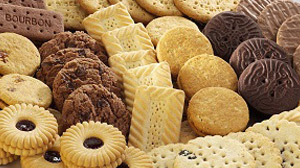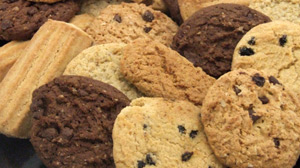Assorted Biscuits
BISCUITS. The word "biscuit" is derived from the Latin panis biscoctus, "twice-baked bread." From the sixteenth to the eighteenth century, forms of the word included besquite and bisket. Similar forms are noted in many European languages. "Biscuit" covers a wide range of flour baked products, though it is generally an unleavened cake or bread, crisp and dry in nature, and in a small, thin, and flat shape. It has a number of cultural meanings. In the United States, a biscuit is a soft, thick scone product or a small roll similar to a muffin. The British biscuit is equivalent to the American cookie and cracker. These latter terms are relatively modern. "Cookie" comes from the eighteenth-century Dutch word koekje, a diminutive of koek (cake). "Cracker" is a North American term that also came into use in the eighteenth century, connoting the sound of the wafer as it was chewed or broken (at this time, "cracker" was also used to mean a firecracker or a noisy person or object). Biscuits have evolved from different aspects of baking practices such as tarts, pastries, short cakes, and sugar confectionery. They have given rise to the wafer, macaroon, cracker, sandwich, snap, gingerbread, honey cake, rusk, and water biscuit. Some, like the wafer, were baked in the Middle Ages; others are of more recent origin, such as the "fancy biscuit," an early-nineteenth-century invention of British bakers that led to the development of a biscuit industry, which was later exported throughout the world. Biscuits are divided into two main groups. The first are plain or have a savory flavoring. The second type are sweet or semi-sweet in character. Biscuits are made from a number of ingredients. Flour is the most basic and important. Different types give a range of textures and crispness. Wholemeal wheat flour is used in the "digestive," "sweetmeal," or "wheat-meal" type of biscuits. Oatmeal forms the basis of oatmeal biscuits. Rice flour and corn flour add flavor. Fats give the biscuits their "shortness." Butter and lard are the main fats, though these are augmented by vegetable and other refined fats. For fancy biscuits, sugar is an important ingredient, and introduces a range of tastes. It is added in several forms: processed as caster and Demerara sugars, syrups, honey, and malt extract. These have a range of consistencies and may help to bind together other ingredients. Aerating and raising ingredients, such as baking powder (bicarbonate of soda and tartaric acid), make the biscuit light. Flavorings are also added. These include dried fruit, nuts, chocolate (powder or chips), spices, herbs, and flavoring essences such as vanilla. The dry ingredients are bound together with eggs and milk (fresh, condensed, or dried) or water. Biscuits have a high energy content, ranging from 420 to 510 kcal per 100 g. |
|








